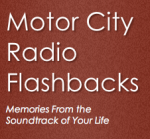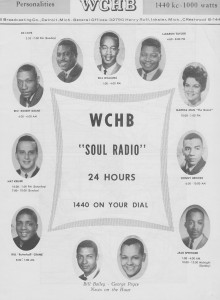 From the MCRFB NEWS archive: 1966
From the MCRFB NEWS archive: 1966
R&B Stations Ride High in Frequency Across Major U. S. Radio Markets
 DETROIT — R&B radio stations are having a banner year and many have turned into powerhouses in major markets in general. For example, WCHB here in Detroit is No. 3 during the daytime in the general market and and after 6 p. m. goes to No. 1. The ratings success story of WOL in Washington in the past year has been the talk of the radio industry. All over the nation, modern R&B stations in general are doing great and program directors point to two factors as having an influence on this — the growing popularity of R&B music among whites as well as Negroes, plus the up-dating of the programming and production at these stations.
DETROIT — R&B radio stations are having a banner year and many have turned into powerhouses in major markets in general. For example, WCHB here in Detroit is No. 3 during the daytime in the general market and and after 6 p. m. goes to No. 1. The ratings success story of WOL in Washington in the past year has been the talk of the radio industry. All over the nation, modern R&B stations in general are doing great and program directors point to two factors as having an influence on this — the growing popularity of R&B music among whites as well as Negroes, plus the up-dating of the programming and production at these stations.
Bill Curtis, program director of WCHB here in Detroit, recently commented that, “This station has been building up over the past two years. It’s owned by two Negro doctors who’ve been extremely involved in community affairs, so people look to us as leaders in the community.

“Too, our sound is as good or better as any station in town. We have strong deejays: Bill Williams is one of the best in the country, a top 40 type of personality. And we have Martha Jean Steinberg. All of our personalities are just as smooth, as competent as any jock on any station.”
Like other program directors, Curtis felt the over-all status of the R&B deejay has made tremendous progress in the past year. And one reason why they have achieved status in the community, he said, “is that in the old days the stereotyped R&B deejay said anything that came to mind. It often offended people or was distasteful. Today, with modern production and tight programming, the deejay only have time for news, temperature, announcing the time, and playing records. There is very little time left in possibly saying the wrong thing.”
KYOK in Houston is another station achieving success. Program director Al Garner said that R&B radio “period” is looking better in Houston. Sitting in for vacationing deejays during the past few weeks, Garner said he noticed that his station was picking up a growing number of Latin listeners, as well as white kids. The station runs third and fourth now in the general market, he said, and competes on the general market level for advertising.
Lucky Cordell, program director of WVON in Chicago, said the status of R&B deejays, at least, was improving. “E. Rodney Jones and Pervis Spann own a nightclub. Herb Kent has just opened a ballroom for record hops. It’s now a prestige factor to be an R&B deejay. Deejays are respected in the community.”
He likened the success of R&B stations in the past few months with the civil rights movement — “We’ve become more and more a source of information. We’re doing a much better job of reporting the news that involves Negroes than the other station in now. Whereas R&B stations used to be mostly for the kids, this is no longer true.” The station, he said, helped “a good deal in settling the people down during a recent flare up.”
George Wilson, program director of WHAT in Philadelphia, said there’s no question about the status of the R&B deejay improving. The National Association of Radio Announcers, he said, had helped enormously. “There’s a growing substance to the organization and it’s making an influence.
“Nowadays, the successful R&B radio stations are the ones with the hip young guys who understand what radio is all about or the older deejays who were intelligent enough to adjust and grow with the times. The quality of deejays on R&B stations have improved. Here, for example, our regular weekly meetings are intelligent discussion sessions. I can bring up a matter and get an intelligent response; we come up with a workable solution.”
He felt that all R&B stations have shown audience increases this summer despite issues of racial problems, but believed they would keep this audience this fall and not lose them. WHAT is playing, records by Frank Sinatra, Dusty Springfield and Chris Montez . . . “any record the Negro people want to hear. He picks up the information at local Negro nightclubs, which he makes it a point to visit once or twice a week to listen to the tunes being played most on jukeboxes.”
WVKO in Columbus, Ohio, has made tremendous strides commercially, said program director Bill Moss. He felt there was a general “uplift” attitude throughout Negro radio. “This is one of the things NARA is preaching and and those stations that are already not in style are at least becoming aware of the progress being made by the better radio stations.” R&B radio stations now have to assume a role of leadership that “we didn’t before. We must assume the responsibility of uplifting the kids.”
WDIA in Memphis sets an enviable position; it has been No. 1 in the market for about 17 years, said program director Bob McDowell, largely through community involvement. The station supports 145 baseball teams with equipment, provides two buses to take handicapped children to school daily, supports a school for crippled children, plus other goodwill projects. McDowell said he felt the status on R&B deejays have improved. “I can tell by the quality of the men who’ve come here in the past three years; they’re good, high quality personalities which is one reason why we’re on top.”
The popularity of R&B music is growing, he said, “even here,” in Memphis, considered to be one of the leading R&B markets of the nation. END
___
(Information and news source: Billboard; August 13, 1966)
![]()
